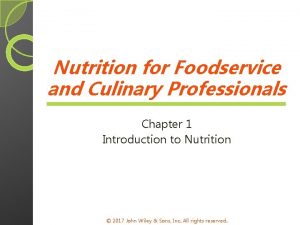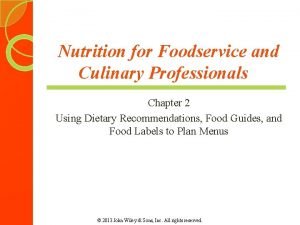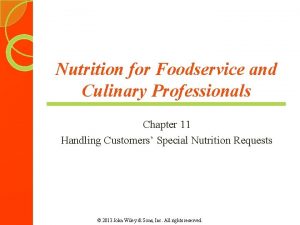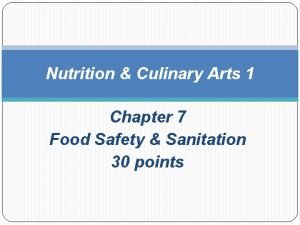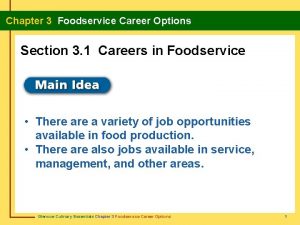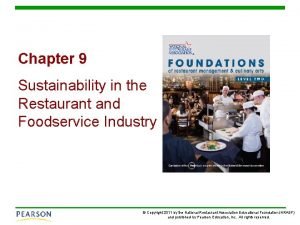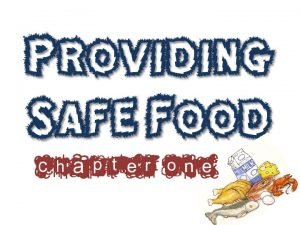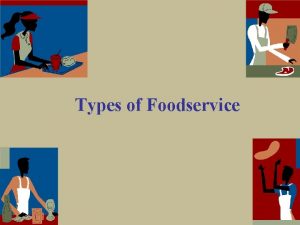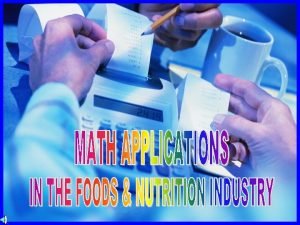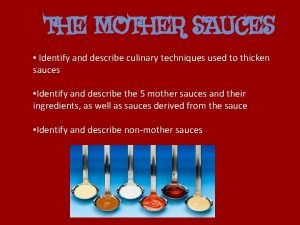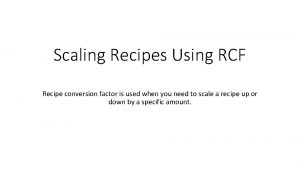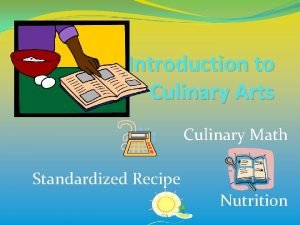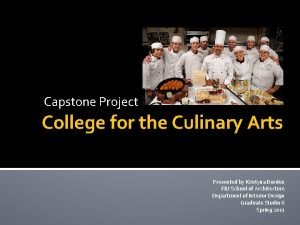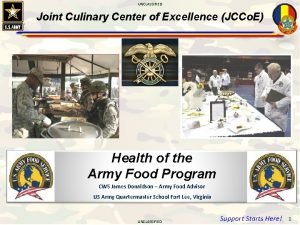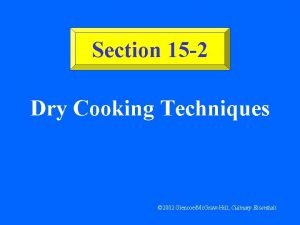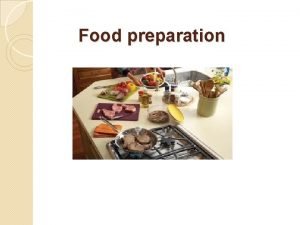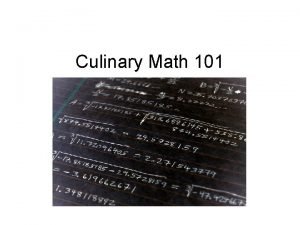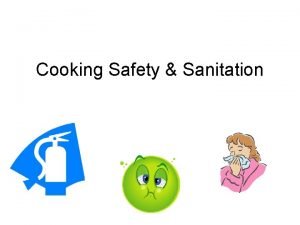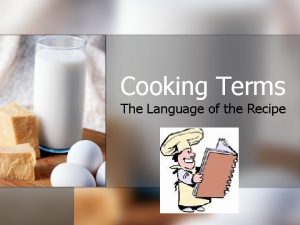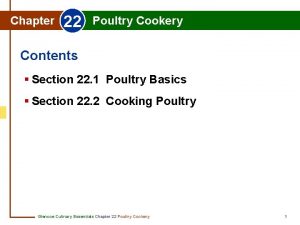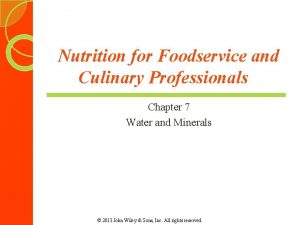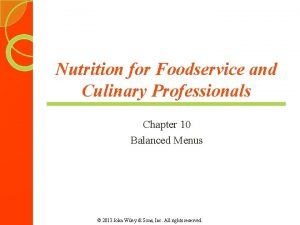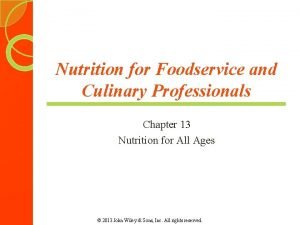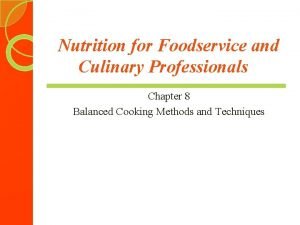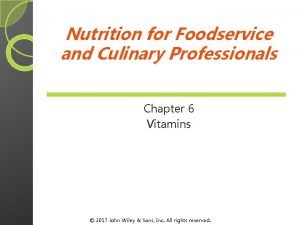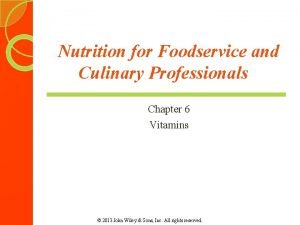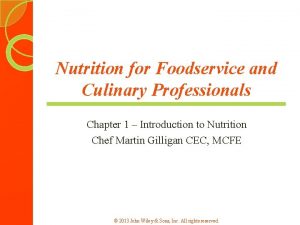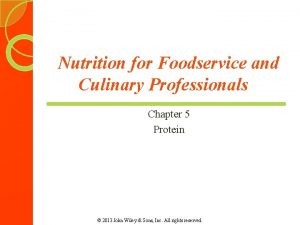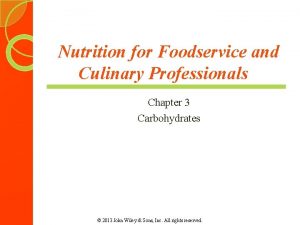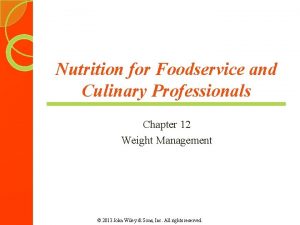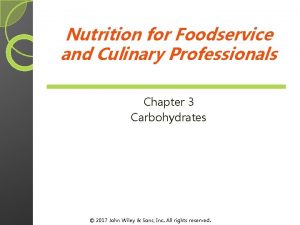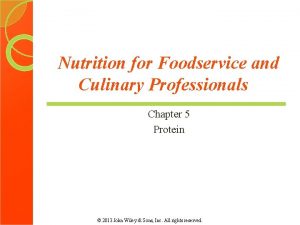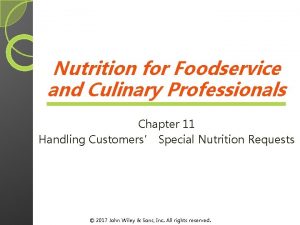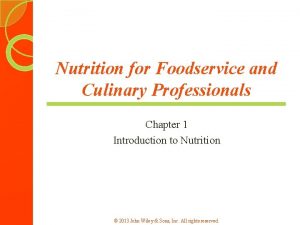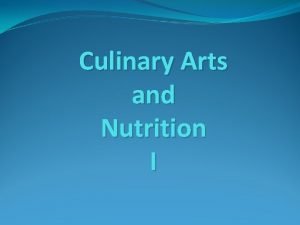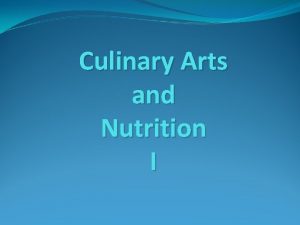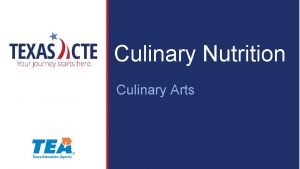Nutrition for Foodservice and Culinary Professionals Chapter 1


















































- Slides: 50

Nutrition for Foodservice and Culinary Professionals Chapter 1 Introduction to Nutrition © 2017 John Wiley & Sons, Inc. All rights reserved.

Learning Objectives � Explain why nutrition is important including the components of a healthy diet. � Give examples of nutrition and food terms discussed in this section. � Discuss five factors that influence what you eat. � Identify factors that influence how many kcalories you burn each day, and the functions, kcalories, and Dietary Reference Intakes of each class of nutrients. © 2017 John Wiley & Sons, Inc. All rights reserved.

Learning Objectives � Explain how food is digested and absorbed in the gastrointestinal tract. � Give examples of how a chef may run a sustainable restaurant, particularly in terms of purchasing food. � Identify reliable sources of nutrition and health information. © 2017 John Wiley & Sons, Inc. All rights reserved.

Why is Nutrition Important? What is a Healthy Diet? What is nutrition? � A young science. � Looks at nutrients—the nourishing substances in food that provide energy and promote the growth and maintenance of the body. � Looks at how nutrients and other substances in food relate to health and disease. � Explores why you choose the foods you do – in other words, the type of diet you eat. © 2017 John Wiley & Sons, Inc. All rights reserved.

Why is nutrition important? �Your diet (the foods you normally eat & drink – also called an eating pattern) strongly influences whether you will get certain diseases such as: ◦ ◦ Heart disease High blood pressure Diabetes Some cancers � About half of American adults have 1 or more preventable diseases that are related to poor diet and not getting enough exercise. � In addition, more than 2 out of every 3 adults is overweight or obese, as well as 1 out of 3 children. © 2017 John Wiley & Sons, Inc. All rights reserved.

The American Diet �Low ◦ ◦ in: �High Vegetables Fruits Whole grains Dairy ◦ ◦ ◦ in: Kcalories Sodium Saturated fat Refined grains Added sugars © 2017 John Wiley & Sons, Inc. All rights reserved.

A healthy diet is… Higher in: Moderate in: Lower in: Vegetables Alcohol Red and processed meats Fruits Sugar-sweetened foods and drinks Whole grains Refined grains Low- or no-fat dairy Seafood Beans and peas Nuts © 2017 John Wiley & Sons, Inc. All rights reserved.

Nutrition & Food Terms to Know � Whole foods: Foods pretty much as we get them from nature (eggs, fresh fruits and vegetables, beans and peas, whole grains, fresh meat, milk) � Processed foods: Foods prepared using milling, cooking, freezing, canning, dehydrating, or culturing with bacteria (bread, cookies, cereals, sauces, soups, baking mixes, frozen entrees, pasta, snack foods) © 2017 John Wiley & Sons, Inc. All rights reserved.

Whole vs. Processed Food Whole foods are generally not processed or refined. Processed foods are prepared using various techniques such as milling, cooking, freezing, or canning. © 2017 John Wiley & Sons, Inc. All rights reserved.

Enrichment and Fortification � Enrichment: a food is enriched when nutrients are added to replace nutrients that were lost in processing. ◦ Example: breads enriched with iron and several B vitamins � Fortification: a food is fortified when nutrients are added that were not present originally, or nutrients are added that increase the amount already present. ◦ Example: vitamin A in breakfast cereal © 2017 John Wiley & Sons, Inc. All rights reserved.

Natural Foods � Natural means there are no added colors, artificial flavors, or synthetic ingredients. � Natural meat or poultry contains no artificial ingredients or added colors and are only minimally processed. © 2017 John Wiley & Sons, Inc. All rights reserved.

Organic Foods � Organic food is produced without using most: ◦ Conventional pesticides ◦ Petroleum-based fertilizers or sewage sludge -based fertilizers ◦ Bioengineering ◦ Ionizing radiation � Organic farms must be inspected annually. � All organically raised animals may not be given hormones or antibiotics, and must have access to a pasture. © 2017 John Wiley & Sons, Inc. All rights reserved.

Organic Foods � If a food is at least 95% organic, it can use USDA Organic seal. � Do organic foods taste better? � Do organic foods have more nutrients? © 2017 John Wiley & Sons, Inc. All rights reserved.

Superfoods �Phytochemicals – compounds found in plant foods – especially fruits and vegetables – that promote health and protect you from disease © 2017 John Wiley & Sons, Inc. All rights reserved.

Phytochemicals in Foods © 2017 John Wiley & Sons, Inc. All rights reserved.

Ideally, your diet should be: �Moderate (avoid excessive amounts of kcalories or any particular food/food group or nutrient) �Balanced (choose foods to provide essential nutrients in the right proportions) �Varied (eat a wide selection of foods) © 2017 John Wiley & Sons, Inc. All rights reserved.

Why You Eat the Foods You Do � Flavor � Other aspects of food (cost, convenience, nutrition) � Demographics � Culture and religion � Health � Social and emotional influences � Marketing and the media � Environmental concerns © 2017 John Wiley & Sons, Inc. All rights reserved.

Flavor � Includes taste, smell, texture or mouthfeel, temperature, and sounds. � Flavor is a combination of all five senses (taste, smell, touch, sight, and sound). � The most important consideration when choosing something to eat is taste. © 2017 John Wiley & Sons, Inc. All rights reserved.

Taste � You have about 10, 000 taste buds on your tongue, cheeks, throat, and roof of the mouth. � Taste buds for each sensation are scattered around the mouth. � Children under six have more taste buds, and adults over 50 start to lose taste buds. � Young children have more taste buds, so they can often be picky eaters. © 2017 John Wiley & Sons, Inc. All rights reserved.

Five Primary Taste Sensations Sweet Salty Sour Bitter Umami � Umami ◦ Umami provides a savory, sometimes meaty, sensation. ◦ Umami taste receptor is very sensitive to glutamate—an amino acid found in protein such as meat, fish, and milk, and in the flavor enhancer MSG. ◦ Umami flavor increases when salt is added (ketchup, soy sauce, fish sauce). � The heat of hot peppers is felt not by the taste buds but by pain receptors in the mouth that sense heat. © 2017 John Wiley & Sons, Inc. All rights reserved.

Smell � Smell is very important to taste. � Receptors in your nose can distinguish among about 10, 000 scents. � While cooking and while eating, you smell food. � The sense of smell and detecting the aromas in wine are how wine is tasted. © 2017 John Wiley & Sons, Inc. All rights reserved.

Texture or Mouthfeel Textures that people like: � Crispy � Juicy � Creamy � Tender � Firm � Crunchy Textures people generally don’t like: � Tough � Crumbly � Lumpy � Soggy � Watery Textures influence whether you like the food, and also tells you whether the food is fresh. © 2017 John Wiley & Sons, Inc. All rights reserved.

Sight and Sound You eat with your eyes. � Color is very important—it tells you about the flavor and quality of food. � For eye appeal, consider color, size, shape, consistency, and arrangement. � Eye appeal is especially important for cold foods. � Sounds—the sizzle of fajitas—stimulate appetite along with sight. © 2017 John Wiley & Sons, Inc. All rights reserved.

Other Aspects of Food � Food cost � Convenience � Availability � Familiarity � Habits � Nutrition Do these factors impact what you decide to eat? © 2017 John Wiley & Sons, Inc. All rights reserved.

Demographics Women and � Demographics affect food choices. older adults tend to � Demographic factors: consider ◦ Age nutrition more ◦ Gender than men or ◦ Educational level young adults. ◦ Income People with ◦ Cultural background higher incomes and education tend to consider nutrition more. © 2017 John Wiley & Sons, Inc. All rights reserved.

Culture and Religion � Culture is the behaviors and beliefs of a certain social, ethnic, or age group � Religion can affect day-to-day food choices. An example is dietary laws. © 2017 John Wiley & Sons, Inc. All rights reserved.

Other Influences on What You Eat � Health concerns (such as dieting) � Social influences (peer pressure) � Emotional influences (comfort foods) � Marketing and the media � Environmental concerns © 2017 John Wiley & Sons, Inc. All rights reserved.

Kcalories and Nutrients �A measure of the energy in food � One kilocalorie raises the temperature of one kilogram of water one degree Celsius. � Abbreviated as kcalorie or kcal. � When you hear “calorie, ” it is really a kilocalorie. © 2017 John Wiley & Sons, Inc. All rights reserved.

Number of Kcalories Needed � The number of kcalories needed is based on three factors: 1. Basal metabolism (about two-thirds of total energy needs for individuals who are not very active) 2. Physical activity 3. Energy used to digest and absorb food (about 10% of total energy needs) © 2017 John Wiley & Sons, Inc. All rights reserved.

BMR depends on factors such as: Gender Age Growth Height Temperature Fever and stress Sleep Exercise Smoking and caffeine Physical activity accounts for 25 to 40 percent of your total energy needs. © 2017 John Wiley & Sons, Inc. All rights reserved.

Nutrients � Carbohydrates � Vitamins (4 kcal/g) � Fats (9 kcal/g) � Proteins (4 kcal/g) � Minerals � Water No kcalories in vitamins, minerals, or water. Alcohol supplies 7 kcal/g but is NOT a nutrient because it does not promote growth or maintenance of the body. © 2017 John Wiley & Sons, Inc. All rights reserved.

Macronutrients vs. Micronutrients Macronutrients Micronutrients � Carbohydrates � Vitamins � Fats � Minerals � Proteins © 2017 John Wiley & Sons, Inc. All rights reserved.

Carbohydrates �A large class of nutrients, including: ◦ Sugars ◦ Starch ◦ Fibers � Sugars and starches function as the body’s primary source of energy. © 2017 John Wiley & Sons, Inc. All rights reserved.

Fats and Oils � Fats and oils provide a rich source of energy. � Examples: ◦ Butter ◦ Margarine ◦ Vegetable oils ◦ Mayonnaise ◦ Salad dressings © 2017 John Wiley & Sons, Inc. All rights reserved.

Fats and Oils (cont’d) Found in: � Fatty streaks in meat � Poultry skin � Fat in milk, cheese, ice cream � Baked goods � Fried foods � Nuts Foods with little to no fat: � Vegetables � Pasta � Bread � Cereals � Fat-free milk and cheese © 2017 John Wiley & Sons, Inc. All rights reserved.

Protein � Only about 15% of total kcalories come from protein. � Protein is part of every cell, tissue, and organ in the body. � Animal foods are good sources of proteins. � Proteins are present in smaller quantities in plant foods such as grains, beans, and vegetables. © 2017 John Wiley & Sons, Inc. All rights reserved.

Vitamins and Minerals � Noncaloric, nutrients found in a wide variety of foods that are essential to: ◦ regulate body processes. ◦ maintain the body. ◦ allow growth and reproduction. © 2017 John Wiley & Sons, Inc. All rights reserved.

Water � Inorganic nutrient that makes up just over half of the body’s weight � Plays a vital role in all bodily processes � Supplies the medium in which chemical change of the body occur � Aids digestion and absorption, circulation, and lubrication of body joints © 2017 John Wiley & Sons, Inc. All rights reserved.

Your body is about 50 -60% water and 15 -25% fat. © 2017 John Wiley & Sons, Inc. All rights reserved.

Essential Nutrients � Essential nutrients either cannot be made in the body or cannot be made in the quantities needed by the body. � Examples are vitamins and minerals. © 2017 John Wiley & Sons, Inc. All rights reserved.

Six Groups of Nutrients © 2017 John Wiley & Sons, Inc. All rights reserved.

Dietary Reference Intakes (DRI) Recommended Dietary Allowance (RDA) How much you need to take in on a daily basis. Adequate Intake (AI) Intake value used when an RDA cannot be established because there’s not enough scientific data. Tolerable Upper Intake Level (UL) Maximum intake level above which toxicity would increase. � Acceptable Macronutrient Distribution Ranges (AMDR) for adults ◦ Carbohydrate 45– 65% ◦ Fat 20– 35% ◦ Protein 10– 35% © 2017 John Wiley & Sons, Inc. All rights reserved.

Digestion, Absorption, and Metabolism � Digestion: Process by which food is broken down into its components in the gastrointestinal tract with the help of digestive enzymes. � Absorption: The passage of digested nutrients through the walls of the intestines or stomach into the blood, where they are transported to the cells. � Metabolism: All the chemical processes by which nutrients are used to support life. � Probiotics: Live bacteria and yeasts that benefit the digestive system and keep it health – good sources are yogurt and fermented foods. © 2017 John Wiley & Sons, Inc. All rights reserved.

What Happens When You Eat? The Gastrointestinal Tract © 2017 John Wiley & Sons, Inc. All rights reserved.

Sustainable Food Systems � Producing meat uses many resources and has serious environmental consequences: ◦ Forests are cut down to create pastures. ◦ Livestock farms pollute water and air and produce manure and greenhouse gases. ◦ Enormous amounts of water, fuel, fertilizers, and pesticides are required to grow livestock feed. Fertilizers require a lot of energy to make and wind up polluting waterways. © 2017 John Wiley & Sons, Inc. All rights reserved.

What is sustainable agriculture? � Sustainable agriculture produces food without depleting the Earth’s resources (water, soil, fuel) or polluting its environment. � It is agriculture that follows the principles of nature to develop systems for raising crops and livestock that are, like nature, self-sustaining. © 2017 John Wiley & Sons, Inc. All rights reserved.

What is a sustainable food system? � Sustainable agriculture is part of a sustainable food system. � Sustainable food systems involve not only growing crops and producing livestock in a sustainable manner, but also processing, packaging, and distributing foods without depleting the Earth’s resources or causing excessive pollution. � In a sustainable food system, food should be affordable and workers, such as farm workers, should make a living wage. © 2017 John Wiley & Sons, Inc. All rights reserved.

What are restaurants doing in terms of purchasing food? Chefs are: 1. 2. 3. 4. 5. 6. 7. Sourcing local, farm-to-table foods Buying organic foods Buying sustainable fish Starting gardens to grow herbs, veggies, etc. Serving meals that are lower on the food chain Buying coffee and tea from sustainable operations Reducing bottled beverages © 2017 John Wiley & Sons, Inc. All rights reserved.

Finding Reliable Nutrition and Health Information �Sources of nutrition and health information: ◦ Registered Dietitians/Nutritionists ◦ Other health professionals © 2017 John Wiley & Sons, Inc. All rights reserved.

Questions to Help Judge Quality of Nutrition and Health Information 1. 2. 3. 4. 5. 6. Who sponsors the website? (. gov, . com, . org. ) How is the website supported? Can you reach the sponsor? Who wrote the information? When was it written? Did anyone review it? Does the website make claims that are too good to be true? Is your privacy protected? © 2017 John Wiley & Sons, Inc. All rights reserved.
 Nutrition for foodservice and culinary professionals
Nutrition for foodservice and culinary professionals Nutrition for foodservice and culinary professionals
Nutrition for foodservice and culinary professionals Nutrition for foodservice and culinary professionals
Nutrition for foodservice and culinary professionals Chapter 11 culinary nutrition
Chapter 11 culinary nutrition Elastin culinary definition
Elastin culinary definition Chapter 3 foodservice career options
Chapter 3 foodservice career options Understanding foodservice operations chapter 2
Understanding foodservice operations chapter 2 Sustainability in the restaurant and foodservice industry
Sustainability in the restaurant and foodservice industry Tcs stands for food
Tcs stands for food Chapter 4 becoming a culinary professional answers
Chapter 4 becoming a culinary professional answers Chapter 14 culinary math
Chapter 14 culinary math What is foodservice
What is foodservice Math is not an essential skill for foodservice managers.
Math is not an essential skill for foodservice managers. Disadvantages of ready prepared foodservice system
Disadvantages of ready prepared foodservice system Noncommercial food service
Noncommercial food service Institusi komersial
Institusi komersial Lincoln foodservice products
Lincoln foodservice products The world of food and beverages chapter 4
The world of food and beverages chapter 4 When installing tabletop equipment on legs
When installing tabletop equipment on legs Taylor commercial foodservice
Taylor commercial foodservice Nnn foodservice solutions
Nnn foodservice solutions Culinary crossword 9.1 eggs and dairy
Culinary crossword 9.1 eggs and dairy Competitive intelligence professionals
Competitive intelligence professionals Families professionals and exceptionality
Families professionals and exceptionality Ctip for acquisition and contracting professionals
Ctip for acquisition and contracting professionals Families professionals and exceptionality
Families professionals and exceptionality Mandoline definition
Mandoline definition Chef culinary conference
Chef culinary conference History of mother sauces
History of mother sauces Rcf cooking
Rcf cooking Harbor college registration
Harbor college registration What are the parts of a standardized recipe
What are the parts of a standardized recipe Culinary terms
Culinary terms Arims labels
Arims labels Culinary arts study guide
Culinary arts study guide Kitchen safety jeopardy
Kitchen safety jeopardy Culinary capstone project ideas
Culinary capstone project ideas Acf certification requirements
Acf certification requirements Joint culinary center of excellence
Joint culinary center of excellence Section 15-2 dry cooking techniques
Section 15-2 dry cooking techniques Food preparation definition
Food preparation definition Culinary crossword 2.1 fire safety
Culinary crossword 2.1 fire safety Culinary math
Culinary math Rancidity meaning
Rancidity meaning Fat tom culinary definition
Fat tom culinary definition What is the white part of an egg called
What is the white part of an egg called What is recipe standardization
What is recipe standardization Dasar kuliner
Dasar kuliner To gently combine two mixtures
To gently combine two mixtures Culinary school in thailand for international students
Culinary school in thailand for international students Poultry cookery
Poultry cookery
